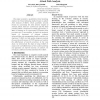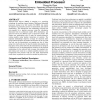1368 search results - page 93 / 274 » A Hybrid Reputation Model Based on the Use of Organizations |
HICSS
2007
IEEE
14 years 4 months ago
2007
IEEE
This paper presents a quantitative threat modeling method, the Threat Modeling method based on Attack Path Analysis (T-MAP), which quantifies security threats by calculating the t...
SAC
2008
ACM
13 years 9 months ago
2008
ACM
Software-based self-test (SBST) is emerging as a promising technology for enabling at-speed testing of high-speed embedded processors testing in an SoC system. For SBST, test rout...
SASO
2009
IEEE
14 years 4 months ago
2009
IEEE
This paper introduces MOCAS (Model Of Components for Adaptive Systems), a generic state-based component model which enables the self-adaptation of software components together wit...
CIBCB
2007
IEEE
14 years 2 months ago
2007
IEEE
Gene regulatory network model is the most widely used mechanism to model and predict the behavior of living organisms. Network Component Analysis (NCA) as an emerging issue for unc...
IWIA
2005
IEEE
14 years 3 months ago
2005
IEEE
Previous quantitative models of security or survivability have been defined on a range of probable intruder behavior. This measures survivability as a statistic such as mean time...


